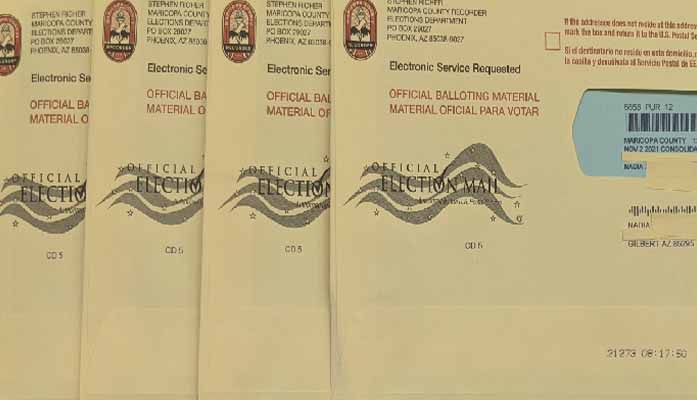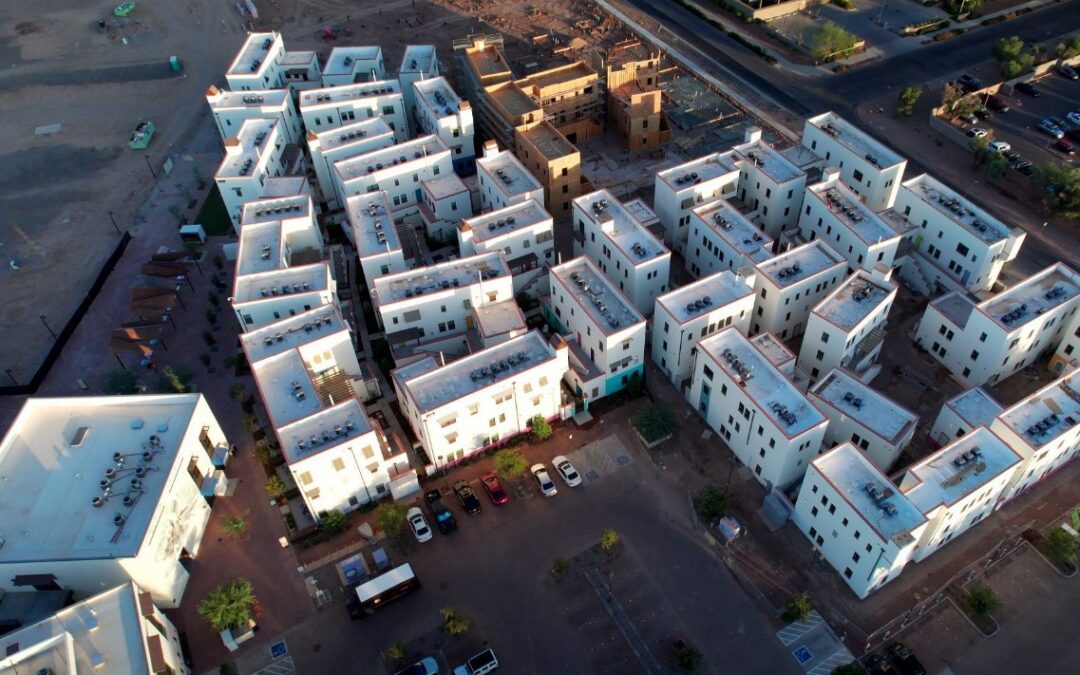
by Corinne Murdock | Feb 29, 2024 | News
By Corinne Murdock |
State Rep. Alex Kolodin (R-LD03) is urging the Arizona Senate to do away with a bill allowing the export of the Valley’s emergency water reserve.
The bill, HB2201 sponsored by State Rep. Tim Dunn (R-LD25), passed the House with bipartisan support, 33-23, on Monday. Kolodin said that such a measure would inevitably raise utility bills.
“HB2201 allows part of Scottsdale’s emergency water supply to be transferred to out-of-county users, raising our utility bills,” said Kolodin. “I voted no. Needs to die in the Senate!”
Kolodin told AZ Free News that HB2201 will serve as a detriment to suburban ratepayers and force cities to compete for the dwindling supply.
HB2201 enables the interbasin transport of cities’ emergency groundwater supply from within the Harquahala Irrigation Non-expansion Area (INA) to any location within La Paz County. Dunn explained during last month’s hearing on the matter in the Natural Resources, Energy, & Water Committee that the bill would allow La Paz County to grow their existing water resources.
The Harquahala INA covers approximately 766 square miles within La Paz and Maricopa counties in the west-central portion of the state. Currently, Harquahala INA water supply may only be withdrawn and transported by the state and political subdivisions to the following initial Active Management Areas (AMAs): Phoenix, Tucson, Santa Cruz, Pinal, and Prescott.
AMAs rely heavily on mined groundwater and therefore come with higher levels of management than INAs. INAs regulate wells in rural farming areas where groundwater overdraft — the removal of too much water — is less severe. There are two other INAs in the state: Hualapai Valley and Joseph City.
These distinctions are outlined by Arizona’s Groundwater Management Act (GMA), passed over 40 years ago, which restricts interbasin water transportation for the state’s 51 groundwater basins in order to ensure AMAs maintain a 100-year water supply, also known as an assured water supply.
Healthy interbasin water transport hinges on a concept known as safe-yield: ensuring a safe balance between groundwater withdrawals and the natural and artificial recharging of water to AMA aquifers. Overdrafting can damage aquifer structure and limit future water storing capacity, increase the costs of drilling and pumping, and reduce the water quality.
Harquahala INA is considered an emergency savings account of sorts for water, saved in the event of prolonged drought: no groundwater has been transported out of the basin since 1990, according to the latest report from the Arizona Department of Water Resources (ADWR), the authority on water management. Yet, ADWR also reported that in almost all years from 2004-2022, the Harquahala INA had more water leaving the basin than entering mainly due to agriculture, which have made up 98 percent of the INA’s demand.
ADWR projected that annual supply would be insufficient for annual demand under any projected scenario over the next 50 years.
Corinne Murdock is a reporter for AZ Free News. Follow her latest on Twitter, or email tips to corinne@azfreenews.com.

by Corinne Murdock | Feb 29, 2024 | News
By Corinne Murdock |
While going to or from Phoenix Sky Harbor Airport, travelers may now make a pit stop at a new nearby marijuana shop.
The store is one of 16 locations in the state owned by Curaleaf, a marijuana dispensary company with 147 locations across 17 states. There are three other marijuana stores near the airport as well: JARS Cannabis, Local Joint by Zen Leaf, and Sunday Good Dispensary.
Marijuana remains illegal under federal law. The Drug Enforcement Administration (DEA) lists marijuana as a Schedule I drug under the Controlled Substances Act: the highest classification shared by some of the most addictive and dangerous illicit drugs, like heroin and crack cocaine. The DEA describes Schedule I drugs as those with high potentials for abuse and creation of severe addiction.
Current DEA data reports that long-term, regular use of marijuana can lead to both physical and psychological dependence and withdrawal, as well as health problems such as bronchitis, emphysema, bronchial asthma, and suppression of the immune system.
The DEA’s take on marijuana may be subject to change in the near future. Last month, the DEA confirmed it was conducting a review to reschedule marijuana. Days later, the Department of Health and Human Services (DHHS) released hundreds of documents outlining its recommendation to DEA to reschedule marijuana to a Schedule III drug.
In the meantime, current DEA scheduling means that marijuana products may not be transported over state lines, even between two states that have legalized marijuana — the Transportation Security Administration (TSA) technically prohibits the inclusion of marijuana in checked and carry-on bags. Officially, passengers may only bring products with .3 percent THC or less on a dry weight basis, or those approved by the FDA.
However, the TSA does disclose that its officers don’t actively look for marijuana during bag checks, and that it’s ultimately up to the officers to determine whether the passenger may proceed to travel with marijuana items.
“TSA’s screening procedures are focused on security and are designed to detect potential threats to aviation and passengers,” states TSA. “Accordingly, TSA security officers do not search for marijuana or other illegal drugs, but if any illegal substance is discovered during security screening, TSA will refer the matter to a law enforcement officer. The final decision rests with the TSA officer on whether an item is allowed through the checkpoint.”
That room for personal judgment appears to be in active use at Phoenix Sky Harbor Airport, according to travelers.
In recent months, some online users out of Phoenix claimed in a Reddit forum that they traveled successfully in and out of the airport with marijuana products.
According to the Arizona Department of Health Services (ADHS) data, there are 200 marijuana facilities and nearly 20,000 providers in the state.
The state legalized recreational marijuana use in 2020. The ballot measure, Proposition 207, ensured that adults over the age of 21 may possess up to an ounce of marijuana legally.
The state imposes both a transaction privilege tax and a 16 percent excise tax on marijuana sales.
Corinne Murdock is a reporter for AZ Free News. Follow her latest on Twitter, or email tips to corinne@azfreenews.com.

by Corinne Murdock | Feb 28, 2024 | News
By Corinne Murdock |
Phoenix resident Brian Anderson received a surprise last week when he checked the contents of his newly-registered UPS mailbox: a mail-in ballot made out to a woman who has lived in Fulton County, Georgia for the past decade.
“This person appears to have been living (and voting!) in Fulton County, Georgia since at least 2015,” said Anderson. “Yet her Maricopa ballots presumably have been mailed to this UPS box every election for the past decade?”
Anderson later reported that he marked the ballot as invalid and returned it to USPS.
Registered voters may obtain a mail-in ballot by either joining the Active Early Voting List (AEVL) or making a one-time request for such a ballot. Under AEVL, voters may receive early ballots by mail indefinitely, so long as they vote at least once every two election cycles, or four calendar years.
Anderson shared with AZ Free News what he’d discovered through public records: the woman named on the ballot had moved out of Arizona around 2013, and has voted in Georgia elections since at least 2016.
“I just don’t understand how no one has marked this lady as inactive after a decade,” said Anderson.
The continued mailing of ballots to ineligible voters doesn’t necessarily mean that those voters have voted in recent past elections.
Under a law passed in 2021 turning the Permanent Early Voting List (PEVL) into AEVL, SB1485, voters are supposed to be removed from AEVL if they haven’t cast an early ballot over the course of two consecutive federal election cycles and fail to respond within 90 days to a mailed notice from the county recorder. Such a response would have to include a written confirmation of that voter’s desire to remain on AEVL, along with their address and date of birth.
Removal from AEVL doesn’t cancel a voter’s registration, and doesn’t preclude the voter from rejoining AEVL.
The law is under ongoing litigation launched by progressive activists currently: Mi Familia Vota v. Fontes. They allege that the laws violate the First, Fourteenth, and Fifteenth Amendments along with the Voting Rights Act by imposing a greater barrier to vote that disproportionately impacts non-white individuals.
The implementation of AEVL is also under the subject of another lawsuit from Arizona’s GOP legislative leaders challenging Secretary of State Adrian Fontes’ Election Procedures Manual (EPM). They alleged that Fontes’ EPM contradicts the implication of SB1485.
Instead of county recorders issuing notices to AEVL members who didn’t cast an early ballot over the 2022 or 2024 election cycles in 2025, Fontes’ EPM directs county recorders to send notices to AEVL members who didn’t vote by early ballot in the 2024 or 2026 election cycles. The GOP leaders argued that the scope of SB1485 included the 2022 election cycle, though Fontes contended that the cycle predated the law’s passage since the cycle began on Jan. 1, 2021.
Corinne Murdock is a reporter for AZ Free News. Follow her latest on Twitter, or email tips to corinne@azfreenews.com.

by Corinne Murdock | Feb 25, 2024 | News
By Corinne Murdock |
The city of Tempe houses the nation’s first planned car-free community: a rental neighborhood called “Culdesac.”
The community is a smaller version of the 15-minute city concept: a design concept in which residents can access daily essentials like work, stores, and schools within a walkable or bikeable 15-minute radius. Culdesac, located on Apache Boulevard, covers 17 acres of land and offers over 700 pet-friendly apartments for rent.
Since Culdesac residents would live without the ability to travel with ease outside the community, the real estate developer partnered with city government and vehicle rental companies to provide transport outside the community.
Valley Metro will provide free rides on the light rail. Lyft, the ridesharing service, will offer 15 percent off their rides. Envoy, an electric carsharing service, will offer reduced rentals at $5 an hour. The company will also have Bird scooters on site, and allocate over 1,000 bike parking spots.
Other partners include Lugg, an on-demand moving company; Lectric eBikes; Cocina Chiwas, a restaurant; and Archer’s Bikes, a bike sales company.
The community has a single central mailroom, one resident gym, one restaurant, one coffee shop, two boutique community shops, one grocery store, and a bike shop.
Many of the staffers behind Culdesac have roots with Opendoor Technologies, an online company based out of San Francisco, California that purchases, flips, and resells residential real estate.
The co-founder and CEO of Culdesac, Ryan Johnson, was on Opendoor’s founding team and their vice president of operations for four years. Additionally, Johnson previously worked for Bain Capital, New York Metropolitan Transportation Authority, and the Chilean government’s urban planning initiatives.
Other former Opendoor colleagues include Tom Barta, Culdesac’s engineering lead who built the software foundation for Opendoor home loans; Vanessa Valenzuela Erickson, Culdesac’s founding team member and advisor who was one of Opendoor’s managers, and formerly an employee for Teach for America and the Salt River Project; Megan Meyer Toolson, Culdesac’s president of sell direct and services who held the same role at Opendoor; and Evan Moore, Culdesac’s partner at Khosla Ventures who was Opendoor’s vice president of product and the co-founder and COO of Doordash.
Studio apartments start at $1,300 a month, while three-bedroom apartments start at $3,200 a month.
The real estate developer said that it also designed its buildings to mitigate the harsh desert heat and sun.
Though its first by design, Culdesac isn’t the first community to be car-free in the nation or in the state. One in Arizona is car-free, but not by choice: Supai, the capital of the Havasupai Indian Reservation located within the Grand Canyon, is a remote community accessible only by an eight-mile hike by foot or mule, or a 3,000-foot helicopter ride.
Several other communities have been car-free, for a variety of reasons: Bald Head Island in North Carolina, Colonial Williamsburg and Tangier Island in Virginia; Daufuskie Island in South Carolina; Fire Island and Governors Island in New York; Halibut Cove in Alaska; Mackinac Island in Michigan; and Santa Catalina Island in California.
Corinne Murdock is a reporter for AZ Free News. Follow her latest on Twitter, or email tips to corinne@azfreenews.com.

by Corinne Murdock | Feb 25, 2024 | Education, News
By Corinne Murdock |
Arizona’s public schools have over $1 billion in surplus, according to the Arizona Department of Education (ADE).
Tim McCain, chief financial officer for ADE, announced the surplus during last week’s meeting in the House Appropriations Subcommittee on State & Local Resources. According to McCain, the maintenance and operations (M&O) budget carry forward is now over $1 billion.
Additionally, the M&O budget carry forward has a generally positive trajectory, growing from $400 million in 2020 to over $1 billion this year. These budgetary increases carried forward function to raise schools’ budgets.
“Budget balance carry forward goes to the next year for their increase, so their budget will be increased by the amount that they carried forward to the next year,” said McCain. “[Schools] would be able to spend those monies in the future as they go forward.”
McCain also reported that the cash not committed to the M&O budget currently amounts to about $300 million, a decrease this year compared to last but an overall increase since 2020.
The school district fund balance increased from $3.5-$3.6 billion for all districts in 2017, to $6.4 billion for all districts in 2023. The percentage of revenue has remained in the 40-50 percent range since 2018.
McCain clarified that some of the funds within the latest balance consists of bond building funds, around $2 billion.
The school district M&O balance has continuously increased from $355 million in 2017 to $1.38 billion in 2023, with the percentage of revenue likewise increasing steadily from six percent in 2017 to 19 percent last year.
McCain explained that these factors contributing to the budgetary growth could be attributed to increased K-12 funding; districts mitigating risk due to inflation, minimum wage increases, current year funding, and drop in enrollment; the teacher shortage; and the lack of a budget balance carry forward cap. Prior to 2017, there was a four percent cap that incentivized a “use it or lose it” approach to budgeting.
Further, McCain said that the federal COVID-19 relief funds served as another factor contributing to budgetary growth. Arizona received over $4 billion in Elementary and Secondary School Emergency Relief (ESSER) funding. Over $277 million expired in September 2022, and over $1.1 billion expired last September. The remaining $2.5 billion are set to expire this September.
“The districts have been able to utilize ESSER funds where they would have normally utilized M&O funds for certain purposes, and be able to carry those funds over into the future,” said McCain.
Another budgetary growth factor according to McCain was the Classroom Site Fund expansion to include Student Support Services in 2022, and a $300-per-student increase in CSF funds.
Corinne Murdock is a reporter for AZ Free News. Follow her latest on Twitter, or email tips to corinne@azfreenews.com.





